Abstract
1. The temperatures of the liver and afferent aortic and portal blood were measured in 20° C acclimated rats at different environmental temperatures (Ta) between 20 and 37° C. The heated-thermocouple technique was used to measure the metabolic heat production of the liver, its blood flow, and to correct the temperature difference between it and the reference junction for blood flow.
2. The temperature of the liver was higher than that of the afferent blood. On raising Ta from 20 to 30° C the liver temperature fell and the temperature difference between the liver and the aortic blood was reduced despite the decrease in the thermal gradient between the liver and the exterior and a small reduction in hepatic blood flow. A further rise in Ta to 37° C led to an increase in the liver and blood temperatures. The same pattern was seen when the temperature differences were corrected for blood flow.
3. Metabolic heat production in the liver decreased when Ta was raised from 20 to 30° C.
4. In a 20° C environment inhibition of non-shivering thermogenesis with propranolol HCl (10 mg/kg body wt. I.V.) led to a fall in the temperature of the liver and its metabolic heat production towards levels found in untreated rats at Ta = 30° C. Consequently, in treated rats the change in metabolic heat production on raising Ta to 30° C was less than in untreated ones.
5. These results are interpreted as evidence for the participation of the liver in thermoregulatory non-shivering thermogenesis.
Full text
PDF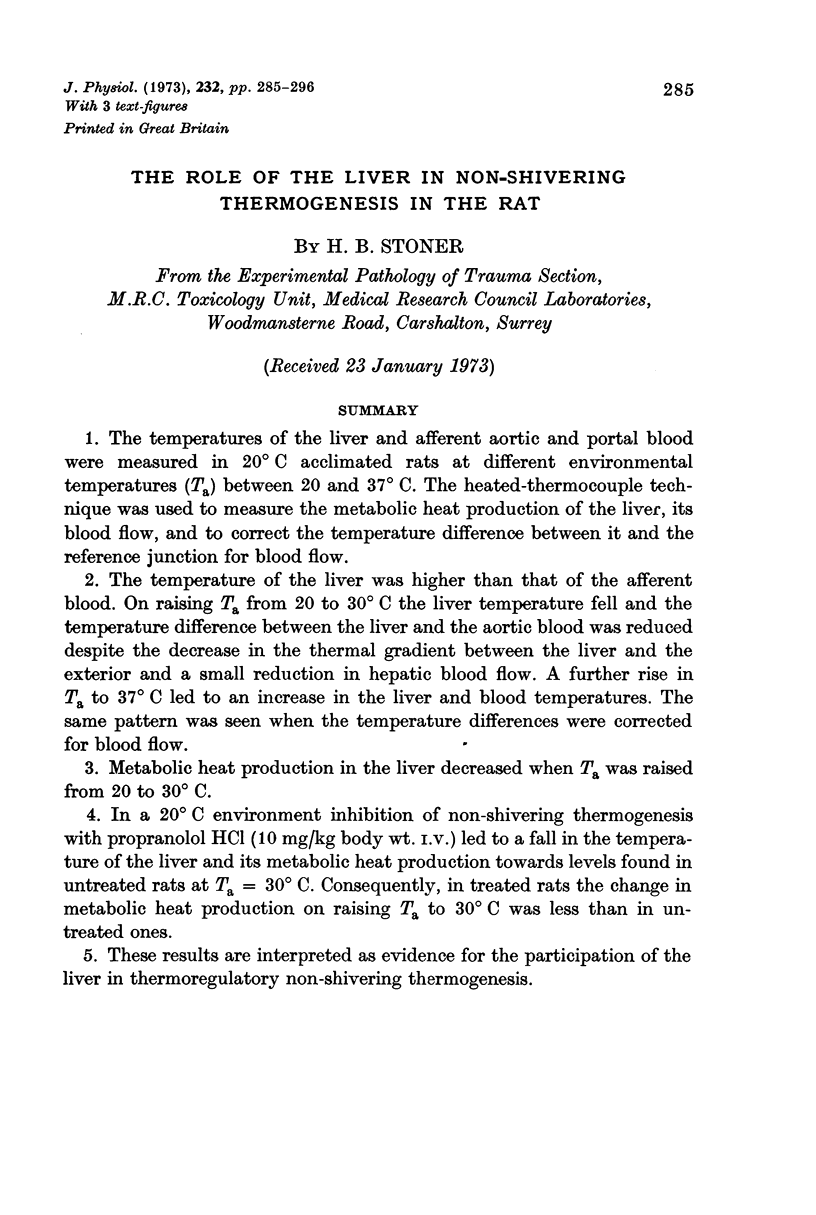
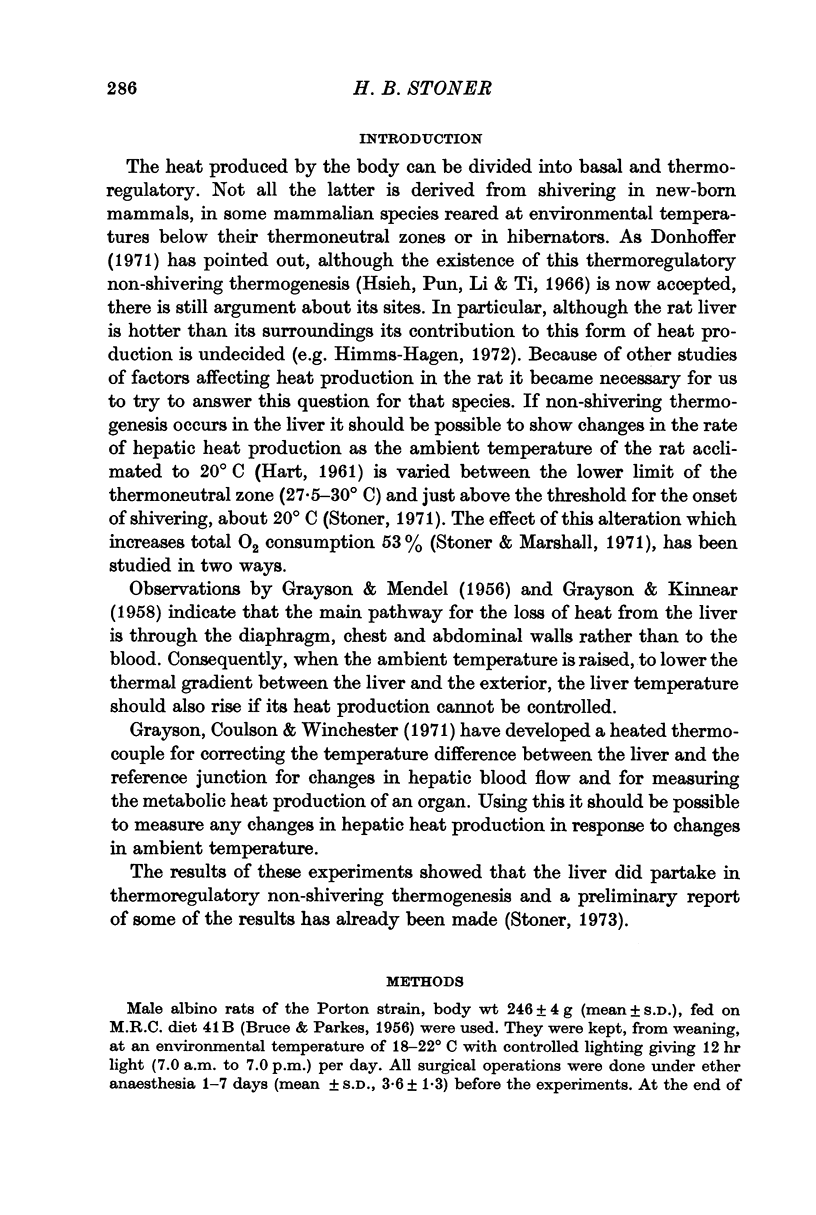
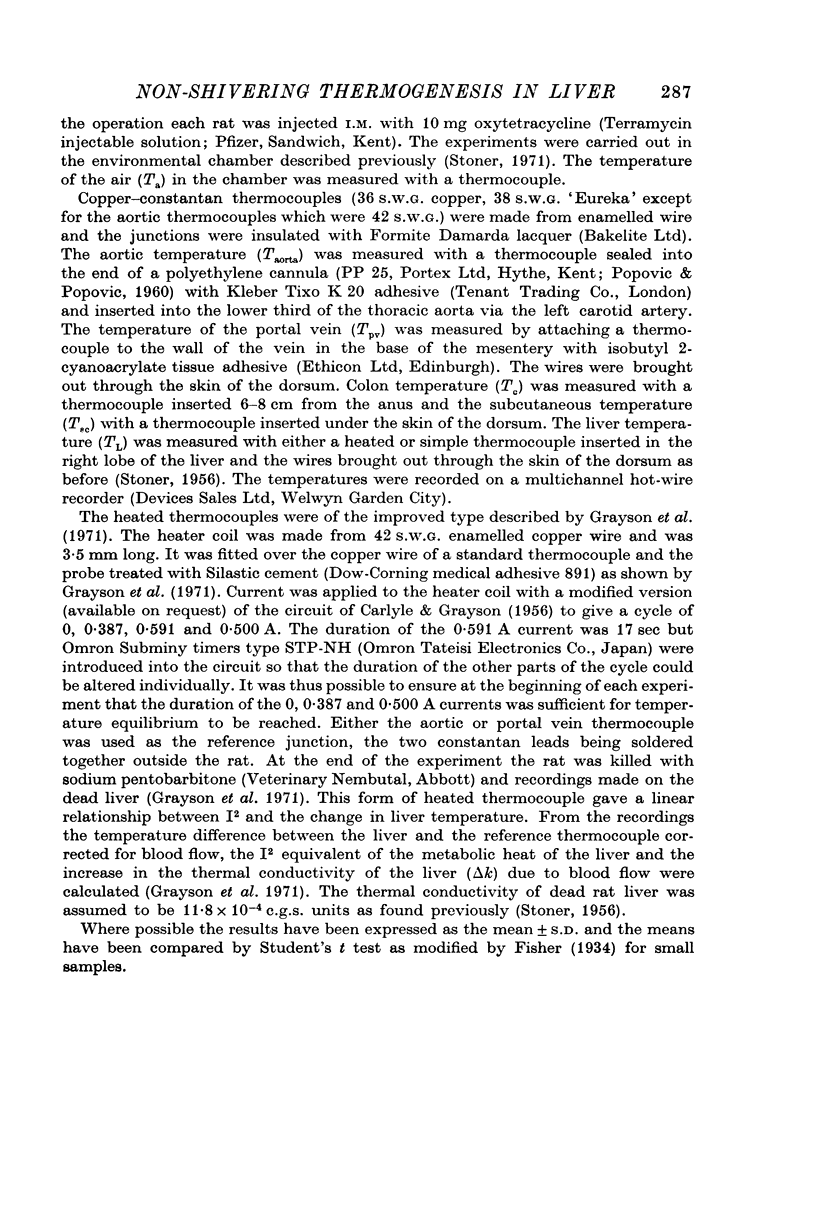
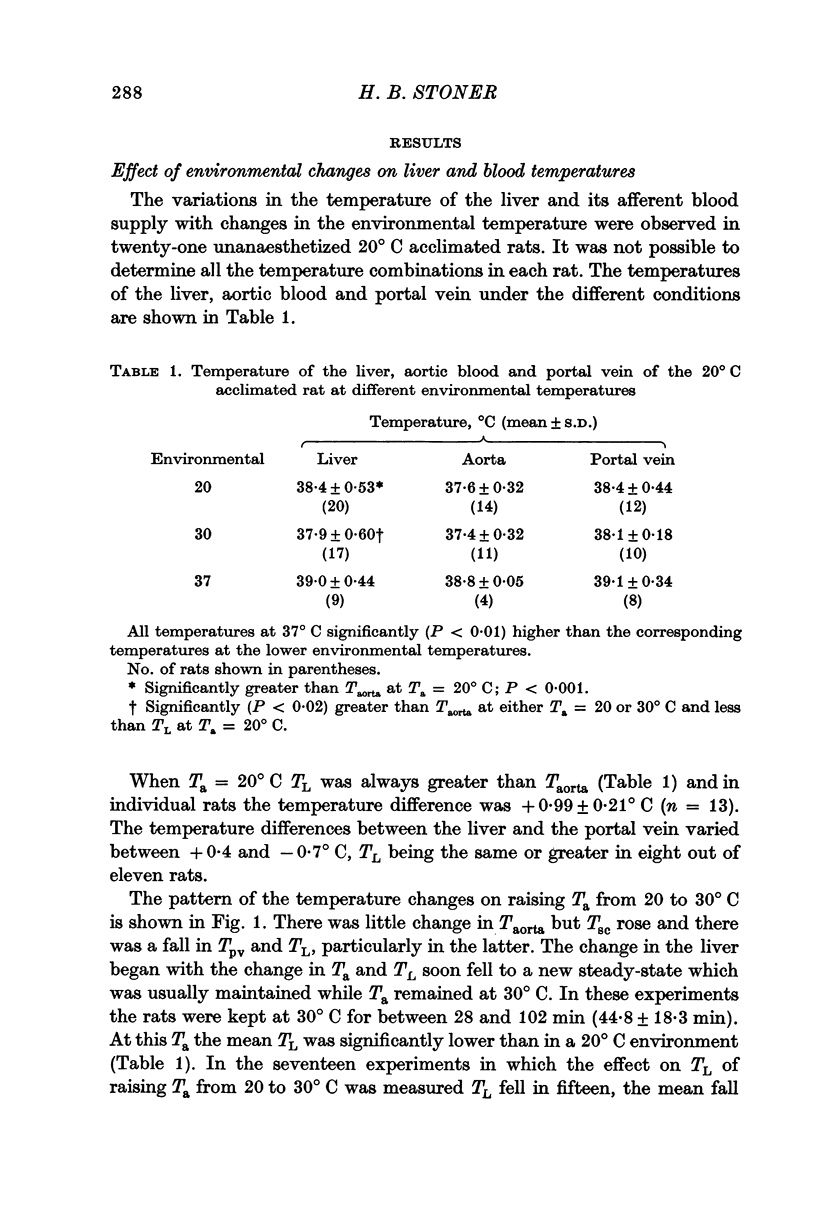
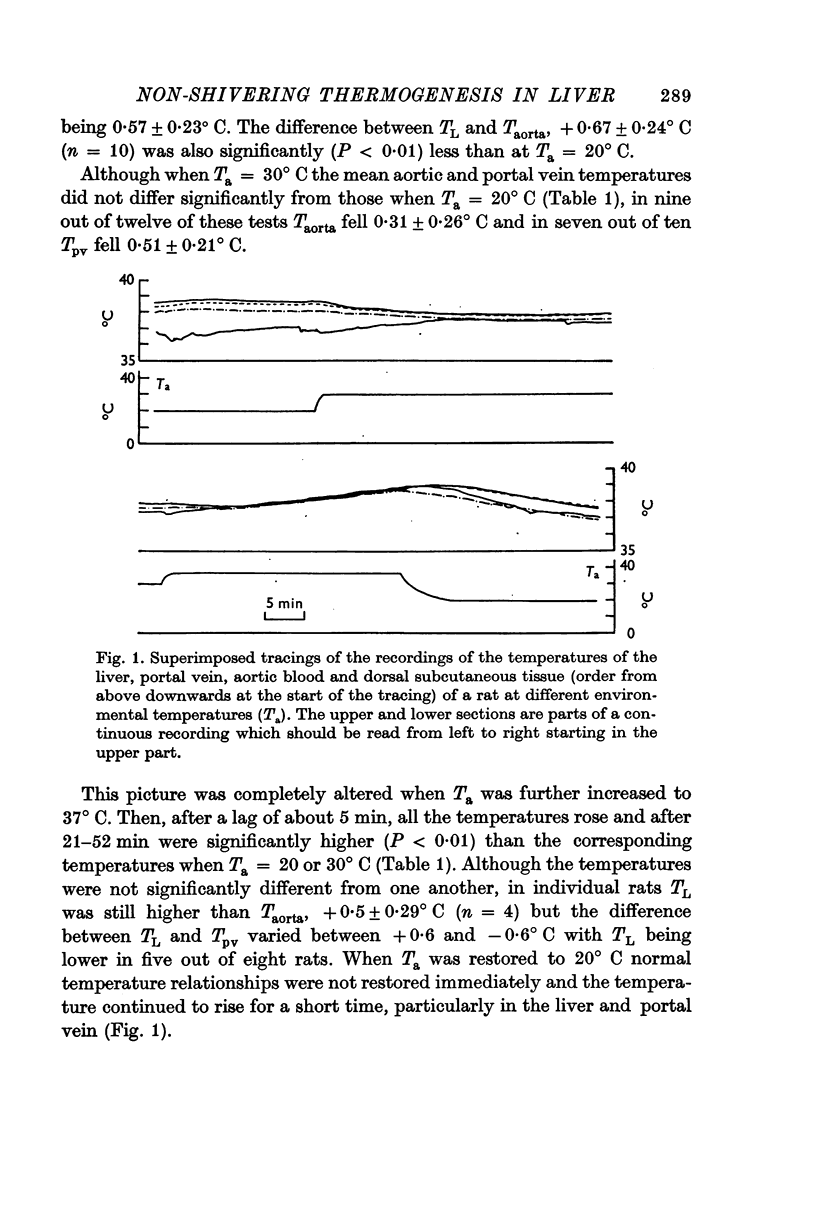
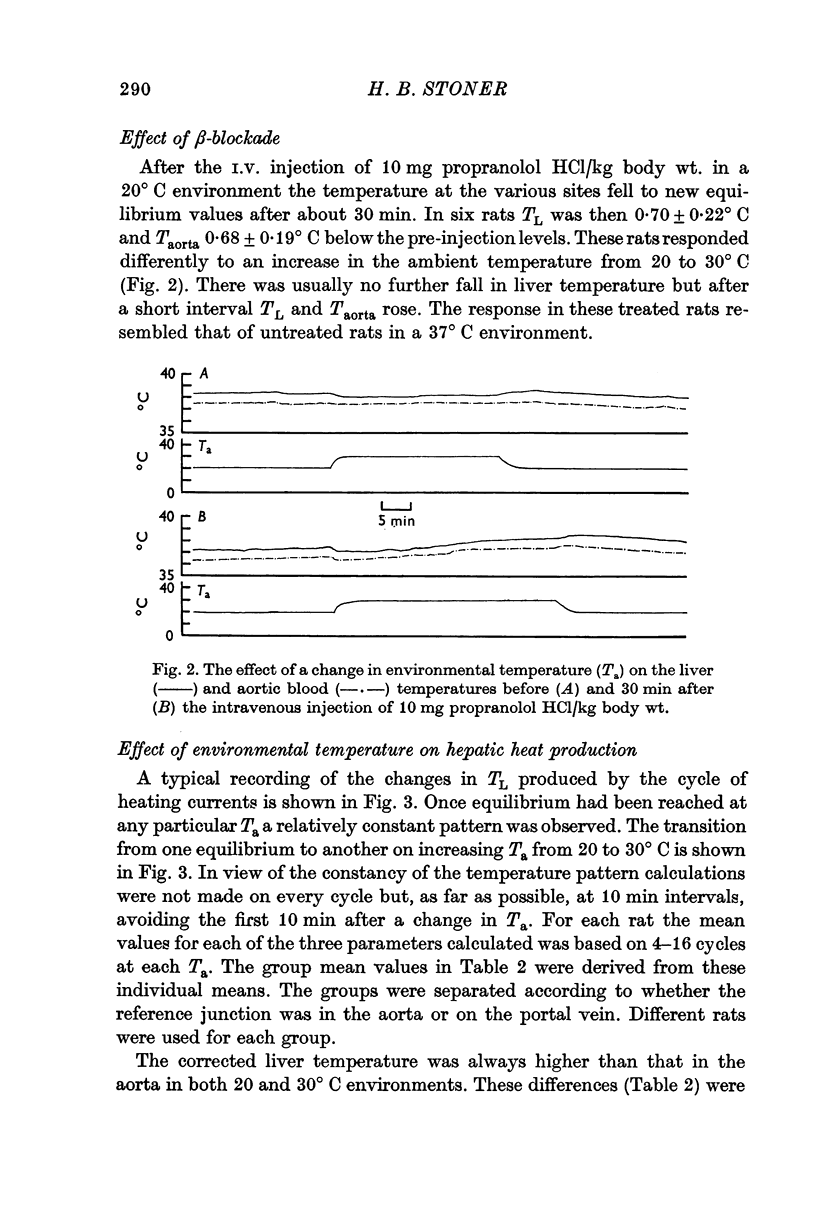
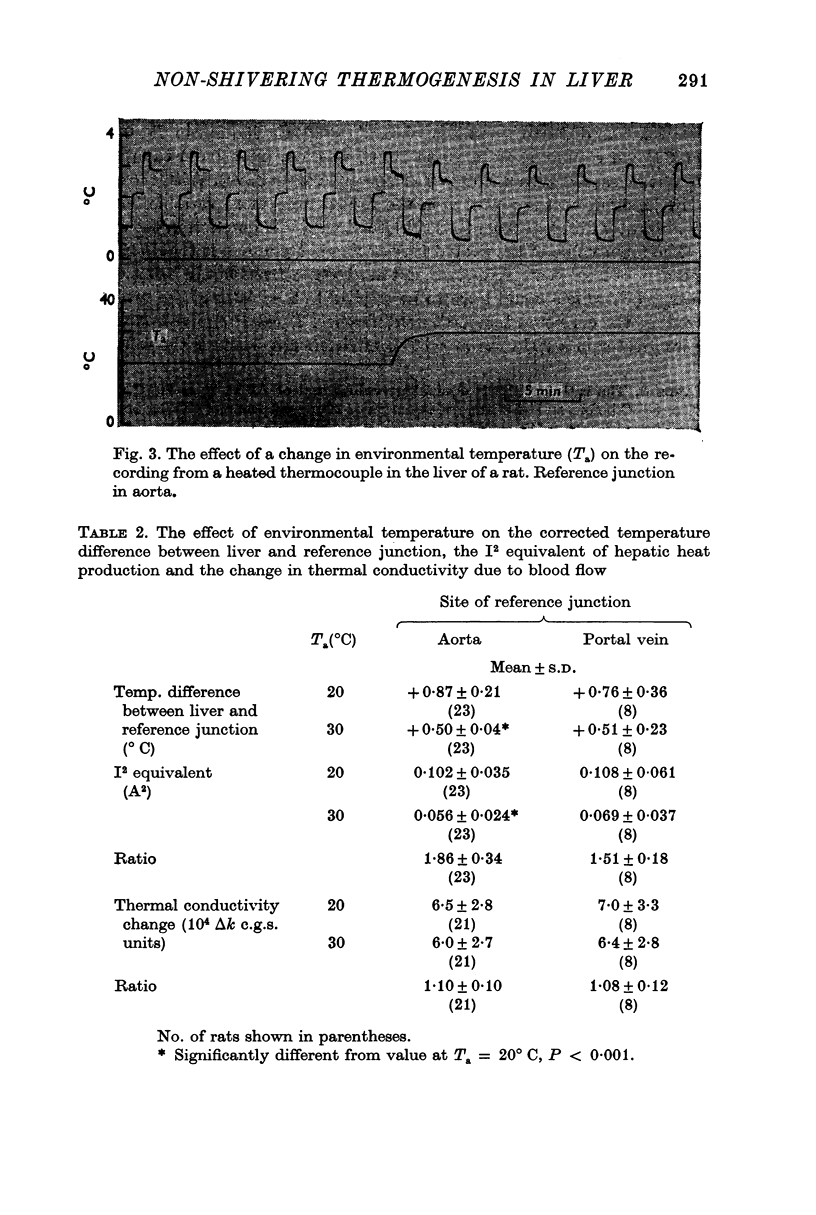
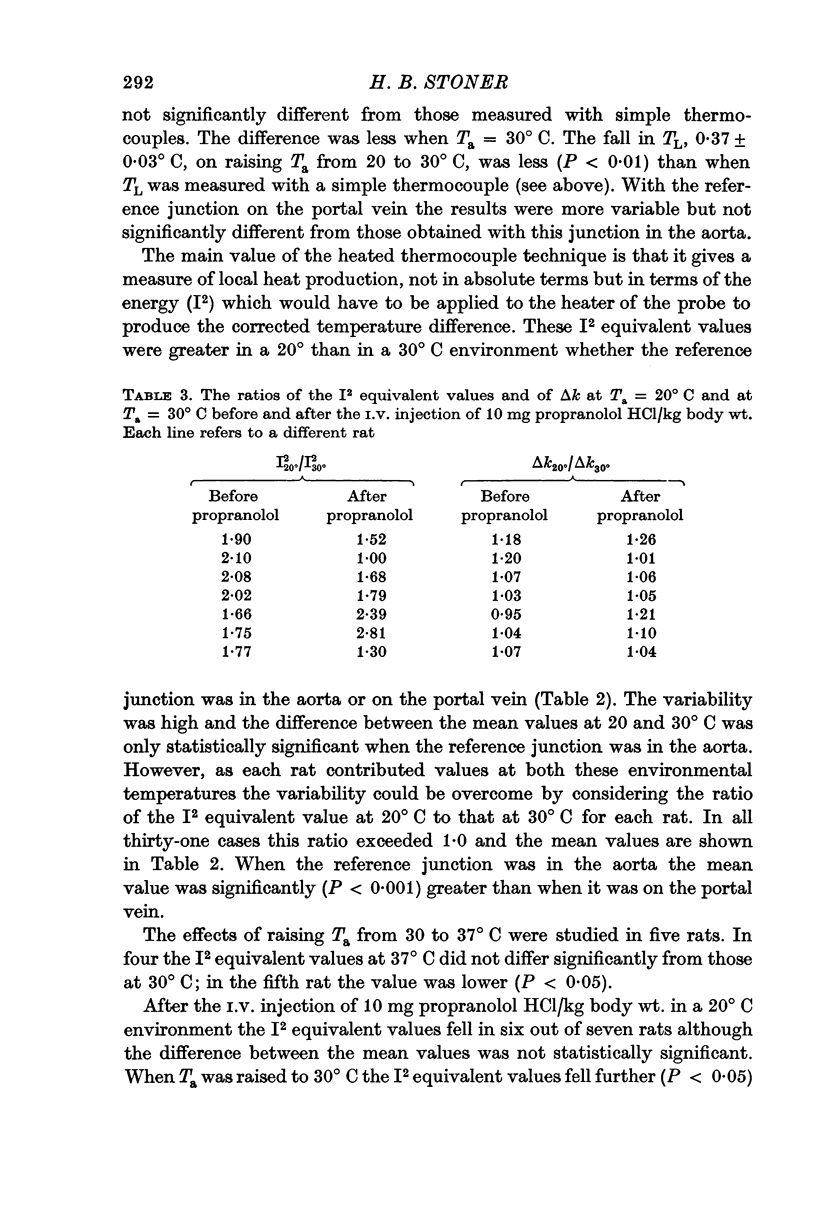
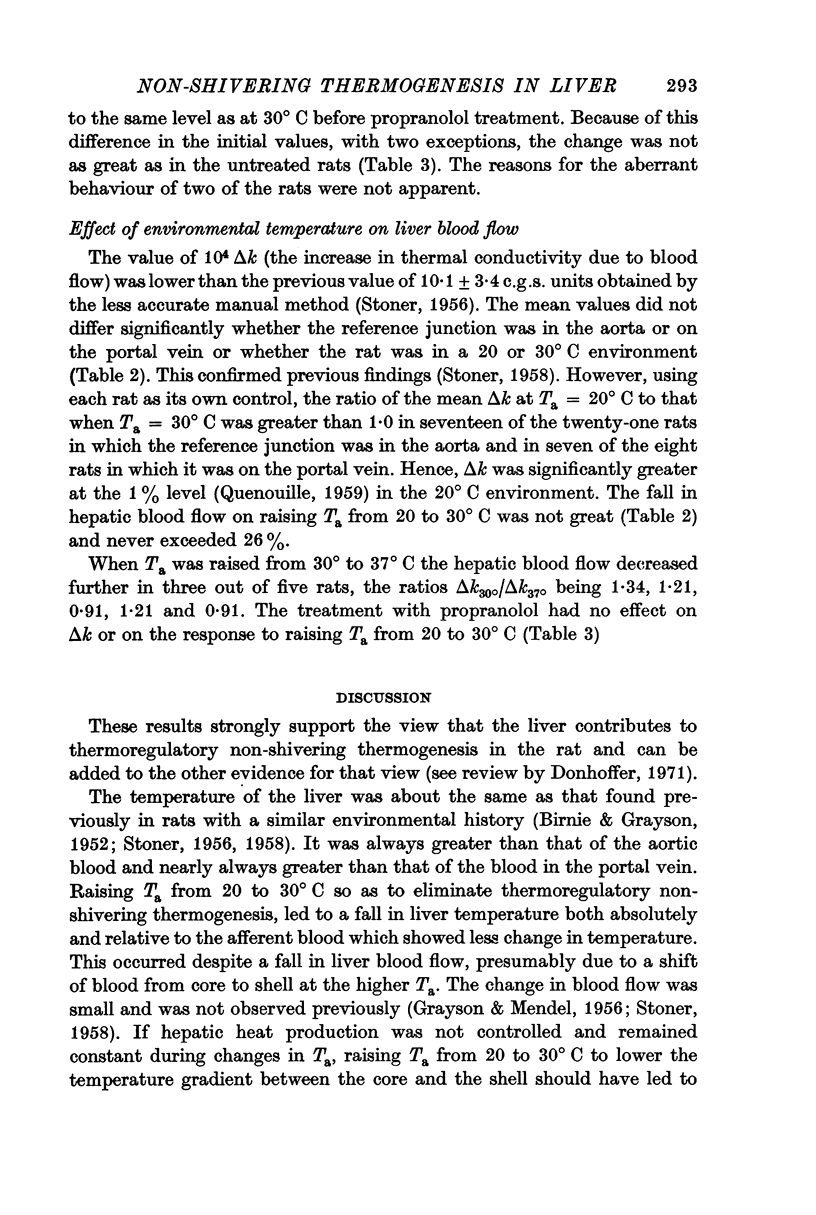
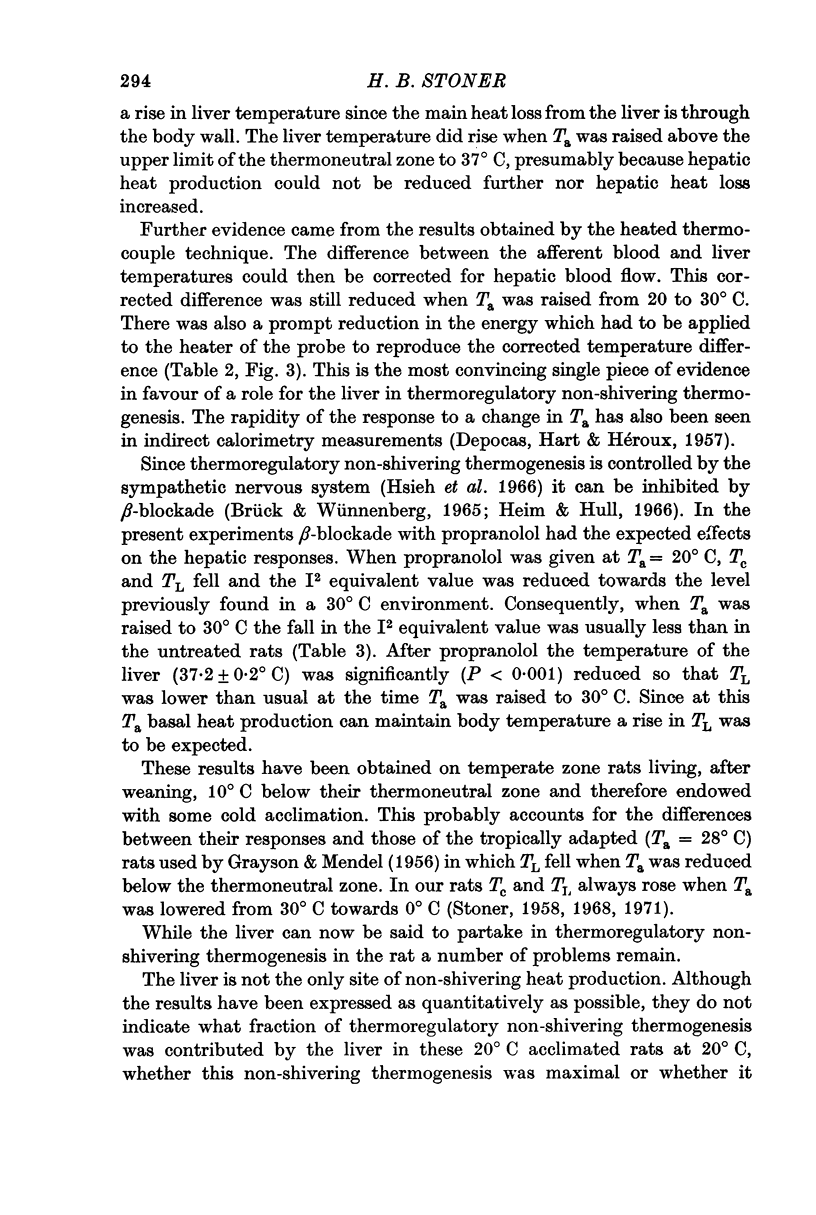
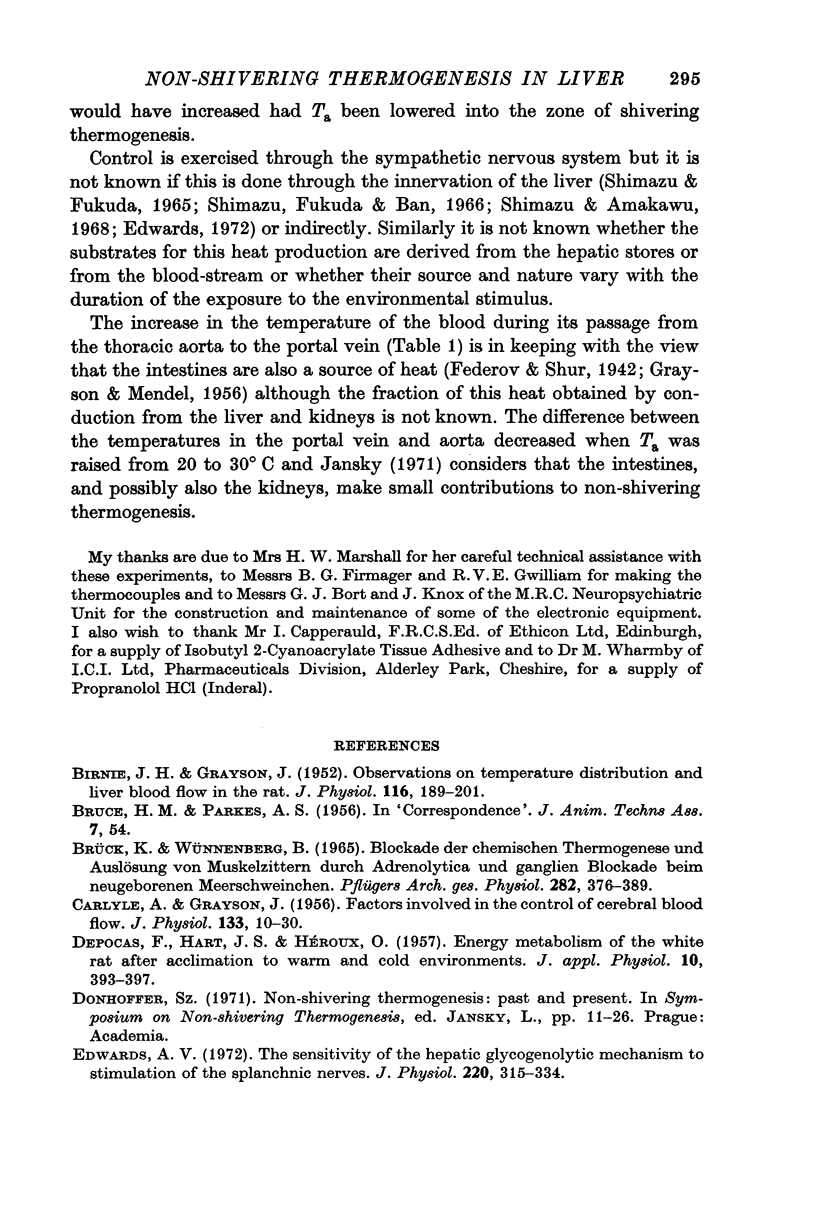
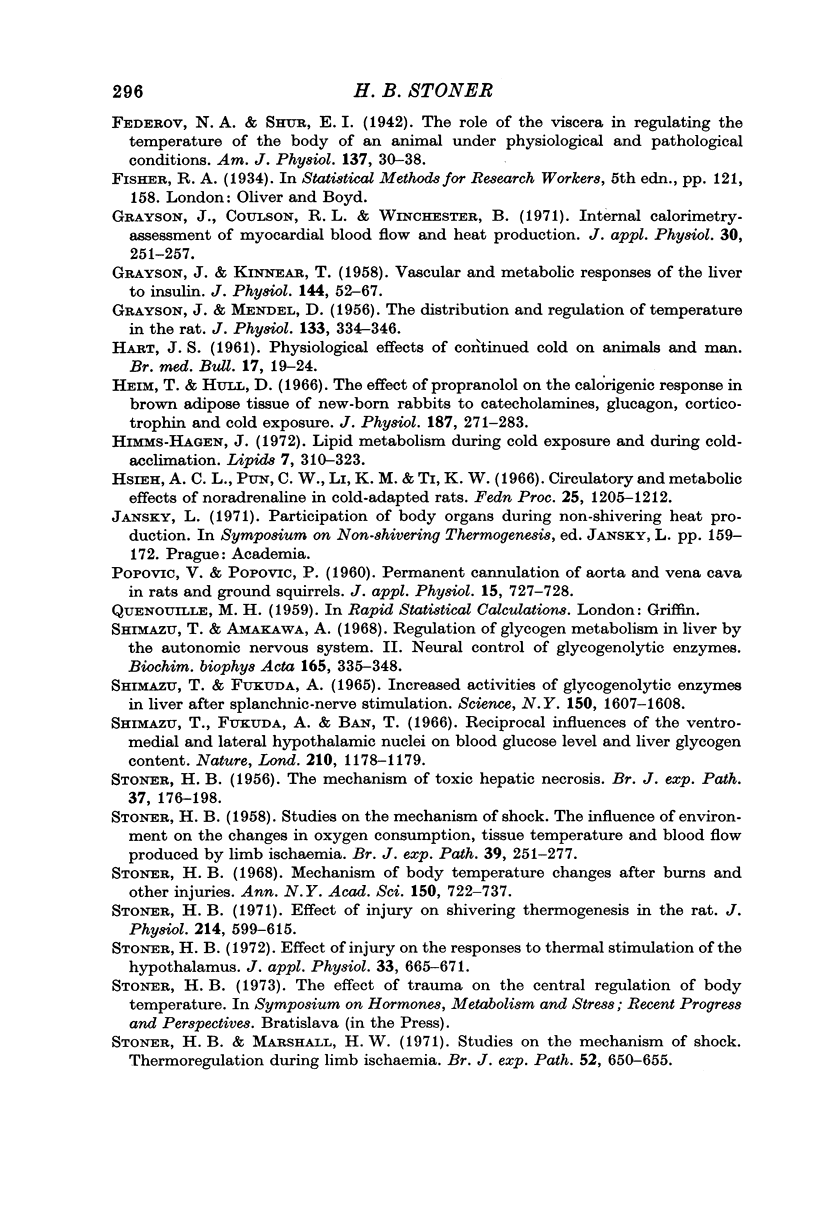
Images in this article
Selected References
These references are in PubMed. This may not be the complete list of references from this article.
- BIRNIE J. H., GRAYSON J. Observations on temperature distribution and liver blood flow in the rat. J Physiol. 1952 Feb;116(2):189–201. doi: 10.1113/jphysiol.1952.sp004699. [DOI] [PMC free article] [PubMed] [Google Scholar]
- CARLYLE A., GRAYSON J. Factors involved in the control of cerebral blood flow. J Physiol. 1956 Jul 27;133(1):10–30. doi: 10.1113/jphysiol.1956.sp005563. [DOI] [PMC free article] [PubMed] [Google Scholar]
- DEPOCAS F., HART J. S., HEROUX O. Energy metabolism of the white rat after acclimation to warm and cold environments. J Appl Physiol. 1957 May;10(3):393–397. doi: 10.1152/jappl.1957.10.3.393. [DOI] [PubMed] [Google Scholar]
- Edwards A. V. The sensitivity of the hepatic glycogenolytic mechanism ot stimulation of the splanchnic nerves. J Physiol. 1972 Jan;220(2):315–334. doi: 10.1113/jphysiol.1972.sp009709. [DOI] [PMC free article] [PubMed] [Google Scholar]
- GRAYSON J., KINNEAR T. Vascular and metabolic responses of the liver to insulin. J Physiol. 1958 Nov 10;144(1):52–67. doi: 10.1113/jphysiol.1958.sp006085. [DOI] [PMC free article] [PubMed] [Google Scholar]
- GRAYSON J., MENDEL D. The distribution and regulation of temperature in the rat. J Physiol. 1956 Aug 28;133(2):334–346. doi: 10.1113/jphysiol.1956.sp005590. [DOI] [PMC free article] [PubMed] [Google Scholar]
- Grayson J., Coulson R. L., Winchester B. Internal calorimetry--assessment of myocardial blood flow and heat production. J Appl Physiol. 1971 Feb;30(2):251–257. doi: 10.1152/jappl.1971.30.2.251. [DOI] [PubMed] [Google Scholar]
- HART J. S. Physiological effects of continued cold on animals and man. Br Med Bull. 1961 Jan;17:19–24. doi: 10.1093/oxfordjournals.bmb.a069858. [DOI] [PubMed] [Google Scholar]
- Heim T., Hull D. The effect of propranalol on the calorigenic response in brown adipose tissue of new-born rabbits to catecholamines, glucagon, corticotrophin and cold exposure. J Physiol. 1966 Nov;187(2):271–283. doi: 10.1113/jphysiol.1966.sp008088. [DOI] [PMC free article] [PubMed] [Google Scholar]
- Himms-Hagen J. Lipid metabolism during cold-exposure and during cold-acclimation. Lipids. 1972 May;7(5):310–323. doi: 10.1007/BF02532649. [DOI] [PubMed] [Google Scholar]
- Hsieh A. C., Pun C. W., Li K. M., Ti K. W. Circulatory and metabolic effects of noradrenaline in cold-adapted rats. Fed Proc. 1966 Jul-Aug;25(4):1205–1212. [PubMed] [Google Scholar]
- POPOVIC V., POPOVIC P. Permanent cannulation of aorta and vena cava in rats and ground squirrels. J Appl Physiol. 1960 Jul;15:727–728. doi: 10.1152/jappl.1960.15.4.727. [DOI] [PubMed] [Google Scholar]
- STONER H. B. Studies on the mechanism of shock: the influence of environment on the changes in oxygen consumption, tissue temperature and blood flow produced by limb ischaemia. Br J Exp Pathol. 1958 Jun;39(3):251–277. [PMC free article] [PubMed] [Google Scholar]
- STONER H. B. The mechanism of toxic hepatic necrosis. Br J Exp Pathol. 1956 Apr;37(2):176–198. [PMC free article] [PubMed] [Google Scholar]
- Shimazu T., Amakawa A. Regulation of glycogen metabolism in liver by the autonomic nervous system. II. Neural control of glycogenolytic enzymes. Biochim Biophys Acta. 1968 Oct 15;165(3):335–348. doi: 10.1016/0304-4165(68)90211-0. [DOI] [PubMed] [Google Scholar]
- Shimazu T., Fukuda A., Ban T. Reciprocal influences of the ventromedial and lateral hypothalamic nuclei on blood glucose level and liver glycogen content. Nature. 1966 Jun 11;210(5041):1178–1179. doi: 10.1038/2101178a0. [DOI] [PubMed] [Google Scholar]
- Shimazu T., Fukuda A. Increased activities of glycogenolytic enzymes in liver after splanchnic-nerve stimulation. Science. 1965 Dec 17;150(3703):1607–1608. doi: 10.1126/science.150.3703.1607. [DOI] [PubMed] [Google Scholar]
- Stoner H. B. 3. Metabolism, heat loss and toxic factors. Mechanism of body temperature changes after burns and other injuries. Ann N Y Acad Sci. 1968 Aug 14;150(3):722–737. doi: 10.1111/j.1749-6632.1968.tb14725.x. [DOI] [PubMed] [Google Scholar]
- Stoner H. B. Effect of injury on shivering thermogenesis in the rat. J Physiol. 1971 May;214(3):599–615. doi: 10.1113/jphysiol.1971.sp009451. [DOI] [PMC free article] [PubMed] [Google Scholar]
- Stoner H. B. Effect of injury on the responses to thermal stimulation of the hypothalamus. J Appl Physiol. 1972 Nov;33(5):665–671. doi: 10.1152/jappl.1972.33.5.665. [DOI] [PubMed] [Google Scholar]
- Stoner H. B., Marshall H. W. Studies on the mechanism of shock. Thermoregulation during limb ischaemia. Br J Exp Pathol. 1971 Dec;52(6):650–655. [PMC free article] [PubMed] [Google Scholar]



